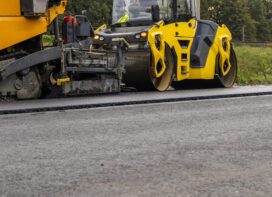

Efficient transportation system, besides leading to the fast economic growth, helps any region in establishing the basic infrastructure facilities for all round development activities. The road network usually has an asset value that represents a significant proportion of national wealth. It is, therefore, important and appropriate that this asset is managed in a scientific manner. Dr. Siksha Swaroopa Kar, Principal Scientist, Flexible Pavement Division, CSIR-Central Road Research Institute, reviews the current scenario of maintenance machinery systems that would help to correct the disorders of the existing pavement to make it roadworthy and improve the present serviceability level of the infrastructure facility.
Compared with construction, the problem of managing road maintenance has proved to be a particularly difficult task for many countries. Road networks are by their nature, spread over a wide geographic area, and their condition is changing continuously as a result of the effects of traffic, climate and environmental conditions.
Postponing road maintenance results in high direct and indirect costs. Studies indicate that repair costs rise to six times of maintenance costs after three years of neglect and to 18 times after five years of neglect. Delayed maintenance has indirect costs as well. The roads steadily become more difficult to use, resulting in increased vehicle operating costs (more frequent repairs, more fuel use) and a reluctance by transport operators to use the roads.
Road Maintenance and Distresses
The goal of maintenance is to preserve the asset, not to upgrade it. Unlike major road works, maintenance must be done regularly. Road maintenance comprises “activities to keep pavement, shoulders, slopes, drainage facilities and all other structures and property within the road margins as near as possible to their as-constructed or renewed condition”. It includes minor repairs and improvements to eliminate the cause of defects and to avoid excessive repetition of maintenance efforts.

The activities include:
- Routine Maintenance: These are routine activities to be performed on a regular basis throughout the year. It consists of both off-carriageway and on-carriageway activities.
- Preventive maintenance: It is performed to improve or extend the functional life of pavement surface while in good condition. By applying preventive maintenance, the deterioration of the road and its components can be slowed down, thus postponing the need for costly investments in rehabilitation and securing the planned design life.
- Periodic Maintenance: This covers renewal of road surface. Normally on rural roads, it may be required at five to six years intervals depending upon the initial construction standards and quality, traffic and weathering effect. It needs to be borne in mind that if routine maintenance is regularly carried out, particularly attending to timely patchwork on the pavement, maintenance of camber/super elevation and side drains, the requirement of periodic maintenance can be postponed.
- Special Repairs: This is required when road structures such as culverts and bridges have suffered serious distress and damage requiring major repairs or even replacement. Repairs of protective works such as breast walls and retaining walls may also be treated as special repairs.
- Emergency Works: This is required when unforeseen events occur such as landslides, floods and earthquakes. The immediate requirement is to reopen the safe passage on the rural road and subsequently plan for and provide for restoring the road to its former or better condition.
- The types of defects in bituminous surfacing are grouped under four categories i.e surface defects, cracks, deformation and disintegrations. Distresses such as Cracking, Rutting, Pothole, Patching, Shoving, Raveling, and Settlement & depression are considered for rating of the bituminous pavement.
In future, there is a clear need for continued research and development in road maintenance technologies. Innovations in machinery, coupled with smart technologies for monitoring and management, can pave the way for more sustainable, cost-effective, and efficient road maintenance practices.

Major maintenance operations covered in this code of practice are sealing of cracking and repair of pothole.
Why Regular Maintenance
Pavement maintenance strategy includes all activities to provide & maintain serviceable roadways. The right treatment on the right pavement at the right time lowers life cycle costs, provides higher quality pavements and keeps good pavements good.
The Figure (2) shows that the pavement condition drops 40% in 75 percent of life of the pavement whereas there is another 40% drop in pavement condition in only 12 percent of the remaining life of the pavement. It is interesting to note that the distress rate of pavement is increasing with time when the pavement is not maintained timely. Furthermore, maintenance of the pavement should be done before its fair-condition is reached so that the lifecycle cost will be less. It can be seen that if periodic maintenance is carried out, the pavement life will increase two fold than the unmaintained pavement.
The figure (3) shows the relationship between investments in road development and socio-economic benefits. Benefits start emerging when a region receives first time road access, as goods, services and facilities become increasingly accessible. After a few years, roads without maintenance become impassable to year round traffic. Initially, the deterioration of the roads only leads to increasing transport costs marginally.
At some point however, traffic conditions, traffic composition and traffic patterns change as the road becomes increasingly non trafficable and the cost of transportation rises drastically. It indicates that the initial investments in providing first time access generate the fastest increase in socio-economic benefits, followed by investments that provide all year access (in areas that only have seasonal access). Maintenance works sustain and compound the benefits generated, while lack of maintenance results in a significant decrease in socio-economic benefits over time.
Available Road Repair Machines
Global practices include prioritising advanced technologies and proactive maintenance strategies, leveraging sophisticated equipment and data-driven approaches. In India, the system takes into consideration the country’s vast geographical expanse, and varying levels of infrastructure development. Indian road maintenance practices often emphasize a blend of innovative solutions tailored to local conditions, with an increasing focus on sustainability, community involvement, and cost-effectiveness. Each machine is analyzed based on repair techniques, technological components, advantages, limitations, and specific machines developed and utilized in various scenarios.

Machines used globally:
- Fully automated cold/hot mobile maintenance unit:
Mounted on a mobile vehicle, this machine consists of a hopper, compressor, multi-axis working arm, auger & conveyor belt, and roller. The process involves filling the hopper, positioning the working arm over the pothole, cleaning the area, delivering mix, and compacting the patch. It offers automation, safety, simplicity, mobility, and all-weather operation but faces challenges in terms of cost-effectiveness.
- Infra-Red Pothole Repair Machine
This machine utilizes infra-red heating for patch work, scarification, and compaction. While it offers advantages such as not requiring cutting/trimming of the repair area and being eco-friendly, it has limitations in terms of depth capacity and classification as a green technique.
- Spray Injection Type Pothole Repair Machine
Designed for cold mix patch work, this machine features dressing tools, compressor, internal high-pressure spray bath system, emulsion tank, hopper for aggregates, and optional sand hopper. The process involves cleaning, spraying binder, simultaneous aggregate and binder spraying, and compaction. It is effective for smaller potholes but relies on operator skill.
- In India, machines used include Mobile Highway Maintenance Van, Tractor-Trailer using Cold-Mix Emulsion for pothole repair and Patch Fill Pothole Repair Machine. The trailer unit features a tractor-driven alternator, walk-behind double drum vibrating roller, emulsion drum lifting provision, and space for stone aggregates. It utilizes cold-mix emulsion for pothole repair, providing an alternative to conventional hot-mix methods.
CSIR-CRRI developed Patch Fill Pothole repair machine uses bitumen emulsion based cold mix technology. Mounted on a mobile vehicle, it facilitates utility cut repairs, pothole repairs, and crack sealing.

Maintenance Strategies:
The strategies for roads vary across different regions based on factors such as climate, traffic volume, available resources, and technological advancements.
Global Strategies
- Proactive Maintenance: This involves regular inspections, timely repairs, and preventive measures to address issues before they escalate.
- Performance-Based Contracts: Some countries implement performance-based contracts for road maintenance, where contractors are incentivized based on the quality and longevity of their work rather than the volume of activities performed. This encourages contractors to focus on delivering sustainable solutions and maintaining high standards.
- Asset Management Systems: Advanced asset management systems are utilized to monitor the condition of roads, prioritize maintenance activities, and allocate resources efficiently. These systems often employ data-driven techniques, such as pavement condition surveys and predictive modeling, to inform decision-making.
In India, there is a shift towards adopting an integrated maintenance framework that encompasses routine, preventive, periodic, and special repairs. This holistic approach ensures comprehensive upkeep of road infrastructure, addressing both surface defects and structural issues.
Public-Private Partnerships models are increasingly being explored for road maintenance projects, leveraging private sector expertise and resources to complement government efforts. These partnerships enable the deployment of innovative solutions, access to specialized equipment, and improved project management practices.
India is investing in capacity building initiatives to enhance the skills and capabilities of maintenance personnel. Training programs, workshops, and knowledge sharing platforms enable technicians and engineers to adopt best practices, utilize modern equipment, and implement innovative solutions. Guidelines were documented by Indian Road Congress for new methodologies on road maintenance for wider acceptability.
By embracing a holistic approach that harmonizes global best practices with local contexts, we can forge a path towards smart infrastructure that propels economic growth and enhances connectivity.
 TrafficInfraTech Magazine Linking People Places & Progress
TrafficInfraTech Magazine Linking People Places & Progress


